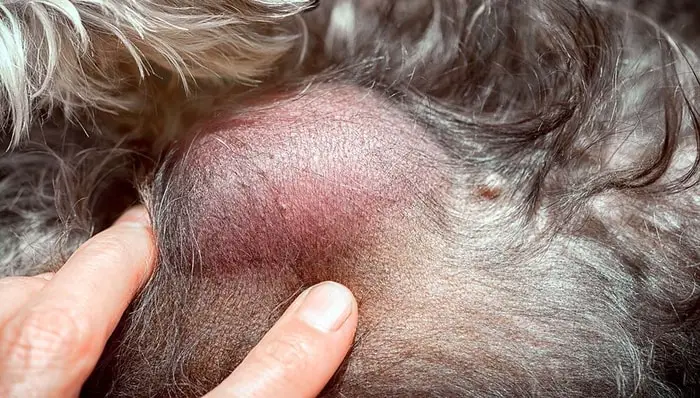Fibrosarcoma in dogs is one of the most aggressive skin cancers of the canine family. The fibrosarcoma is the excessive growth of fibroblast cells of dogs. The fibroblasts are the connective tissue that connects and binds different tissues and organs of the body. The significant locations of fibroblast cells are skin and under the skin. The fibrosarcoma or malignant tumors of fibroblast cells are mainly found in the skin, limbs, and associated tissues. The tumor metastasis to other organs and systems rarely.
Importance of Fibrosarcoma in Dogs
Fibrosarcoma is the soft tissue cancer of dogs commonly found in the skin, long bones, trunk, neck, mouth, and jaws. Fibrosarcoma rarely grows primarily on jaw bones and leg bones. The cancer is slow growing except in leg bones, where it proliferates. The tumor can be removed surgically but again appears due to metastasis. There is no age, gender, or breed discrimination of fibrosarcoma in dogs.

Causes of Canine Fibrosarcoma
The exact causes of the tumor of fibroblast are not known. The significant causes of cancer in dogs and cats are hereditary, environmental, trauma, infectious diseases, foreign bodies, orthopedic implants, and radiations. Middle-aged and older-aged dogs are more susceptible to fibrosarcoma than young dogs. In male dogs, fibrosarcoma in the muzzle and nasal cavity is more common than in other sites.

Dog Breeds Affected By Fibrosarcoma
The following dog breeds are more susceptible to fibroblast cell tumors:
- Golden Retriever.
- Iris Wolfhounds.
- Gordon Setters.
- Doberman Pinscher.
- Brittany Spaniel.

Pathogenesis of Fibrosarcoma in Dogs
Fibrosarcoma is the abnormal growth of fibroblast cells of connective tissue. Initially, the tumor grows very slowly and showing a small nodule under the skin. The nodule gradually turned into a tumor, and it may take few months to several years. The tumors may be ulcerated and vulnerable to any infectious agents. The tumor may invade the bone tissue and destruction osteocytes. The bone becomes fragile, and the dogs become weak.
The fibrosarcoma in dogs is metastasis to other organs in less than 10% of cases. The common sites of the spread of fibrosarcomas are lungs and lymph nodes. The location and staging of the tumors can be diagnosed by X-ray, ultrasonography, blood examination, and biopsy of the tissues.

Clinical Signs and Symptoms of Canine Fibrosarcoma
The clinical signs and symptoms vary on the tumor’s location, size, and extent of the tumor, breed, and age of the affected dogs. The typical clinical manifestations are:
- The tumor initially comes as a slight bulge or nodule under the skin.
- The nodule may be ulcerated, bleeding, and invaded by microorganisms.
- Multiple areas under the skin may be seen, swelling, and pain.
- Hard to touch and moves under the skin.
- The dogs may refuse to eat due to pain.
- The long bones may be fragile, and the dogs are unable to lie down and stand properly.
- Weakness of the dog.
- The tumors in the nasal cavity may cause sneezing, coughing, bleeding from the nose, difficult breathing, and roaring.
- The tumor metastasis to other organs, and animals may die due to shock.
Diagnosis of Fibrosarcoma in Dogs
The initial diagnosis of canine fibrosarcoma can be made by:
- History of disease, age, gender, and breeds of dogs.
- Specific clinical signs like nodule and ulceration in the skin and subcutaneous areas.
- Radiographic examination of skin tumors.
- Ultrasonography of tumors and internal organs.
- CT scan is also helpful in doubtful cases.
- Fine Needle Aspiration (FNA) is one of the best methods of confirmatory diagnosis of fibrosarcoma. The fluid was collected from the tumor and microscopic examination for cytology.
- Biopsy of the tumor cells is another method of confirmatory diagnosis of fibrosarcoma.

Treatment of Canine Fibrosarcoma
The treatment of cancer and tumor has a low prognosis value. The treatment strategies are:
- Surgical removal of tumors is the only effective treatment available. The tumor should be removed by surgical operation or amputation as much as possible to prevent further growth and spread.
- Radiation therapy.
- Chemotherapy.
- The palliative treatment provides good quality nutritious foods and regular health check-ups.
Management and Care of Fibrosarcoma in Dogs
Dogs with fibrosarcoma will never be fully cured. There is a strong chance of recurrence of the disease in the same dogs. You must keep close contact with your veterinarian to check the health status of the dog regularly. You must closely monitor the dog’s behavioral change, feed change, and any abnormalities. You must have an understanding that the dog should live with this disease till his last breath.